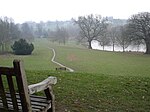Kenilworth
KenilworthTowns in WarwickshireUse British English from December 2017

Kenilworth ( KEN-il-wərth) is a market town and civil parish in the Warwick District in Warwickshire, England, 6 miles (10 km) south-west of Coventry, 5 miles (8 km) north of Warwick and 90 miles (140 km) north-west of London. It lies on Finham Brook, a tributary of the River Sowe, which joins the River Avon 2 miles (3 km) north-east of the town. At the 2021 Census, the population was 22,538. The town is home to the ruins of Kenilworth Castle and Kenilworth Abbey.
Excerpt from the Wikipedia article Kenilworth (License: CC BY-SA 3.0, Authors, Images).Kenilworth
Eden Croft,
Geographical coordinates (GPS) Address Nearby Places Show on map
Geographical coordinates (GPS)
| Latitude | Longitude |
|---|---|
| N 52.341 ° | E -1.566 ° |
Address
Eden Croft 43
CV8 2BG , Windy Arbour
England, United Kingdom
Open on Google Maps








